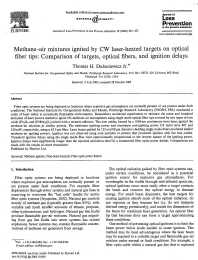Mining Publication: Methane-Air Mixtures Ignited by CW Laser-Heated Targets on Optical Fiber Tips: Comparison of Targets, Optical Fibers, and Ignition Delays
Original creation date: September 2006
Fiber optic systems are being deployed in locations where explosive gas atmospheres are normally present or are present under fault conditions. The National Institute for Occupational Safety and Health, Pittsburgh Research Laboratory (NIOSH, PRL) conducted a study of laser safety in potentially flammable environments. Researchers conducted experiments to estimate the mean and standard deviation of laser powers needed to ignite 6% methane-air atmospheres using single mode optical fiber tips covered by two types of iron oxide (Fe3O4 and (FeMn)(2)O-3) mixed with a ceramic adhesive. The iron oxides, heated by a 1064 nm continuous wave laser, ignited the methane-air mixtures at similar powers. The minimum igniting power and maximum non-igniting power (10 tests) were 407 and 350 mW, respectively, using a 62.5 mu m fiber. Laser beams guided by 125 and 80 mu m diameter cladding single mode fibers produced similar methane-air igniting powers. Ignition was not observed using coal particles at powers that produced ignition with the iron oxides. Threshold ignition delays using the single mode fiber were approximately proportional to the inverse square of the igniting power. Ignition delays were significantly longer than the reported activation time for a commercial fiber optic power limiter. Comparisons are made with the results of other researchers.
Authors: TH Dubaniewicz
Peer Reviewed Journal Article - September 2006
NIOSHTIC2 Number: 20030788
J Loss Prev Process Ind 2006 Sep; 19(5):425-432
See Also
- Explosion Prevention in United States Coal Mines
- A Fail-Safe Control System for a Mine Methane Pipeline
- Ignition of Hydraulic Fluid Sprays by Open Flames and Hot Surfaces
- Ignition of Methane-Air Mixtures by Laser Heated Small Particles
- Ignition Tests With a Fiber-Optic Powered Instrument
- Laser Ignition of Flammable Gas
- Lasers
- Remote Fiber-Optic Methane Monitor
- Technology News 530 - Frictional Ignition of Methane-Air in the Presence of Liquid Hydrocarbons
- Threshold Powers and Delays for Igniting Propane and Butane-Air Mixtures by CW Laser-heated Small Particles
- Content source: National Institute for Occupational Safety and Health, Mining Program


 ShareCompartir
ShareCompartir
